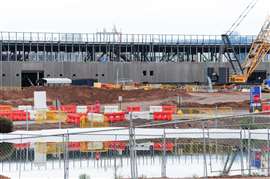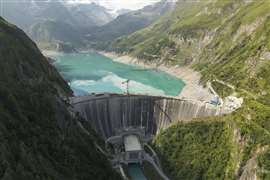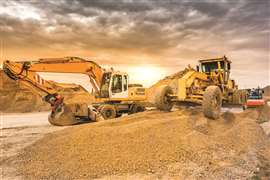Read this article in Français Deutsch Italiano Português Español
Trump unveils US$70bn AI plan with data centres and grid upgrades
16 July 2025
A sweeping push to accelerate artificial intelligence infrastructure in the US could drive a new wave of data centre and energy-related construction, following dual announcements this week from political and private-sector leaders.
The announcements, and the rising flurry of data centre projects cropping up across America, could mean ample opportunities for contractors versed in constructing high-tech facilities.
Helping put in perspective the scale of investment for Construction Briefing is Bryan Williams, portfolio manager of building construction field systems at US-based construction technology firm Trimble. Back in June, he discussed the US data centre construction market, it’s challenges, and what the industry can expect in the future.
 Bryan Williams, Trimble
Bryan Williams, Trimble
Trump pushing Pennsylvania US$70bn AI initiative
On 16 July, at an AI and energy summit in Pittsburgh, Pennsylvania, US President Donald Trump and Republican Senator Dave McCormick of Pennsylvania revealed plans for a US$70 billion joint venture aimed at building data centres powered by natural gas and supported by regional grid upgrades.
Developers say the programme could generate about 6,000 construction jobs annually, with another 3,000 permanent roles tied to AI facility operations.
The initiative will prioritise site remediation and retrofits across former steel and coal sites in the US Rust Belt, with Aliquippa, Pennsylvania – located near the Ohio border – named as a pilot location. The area is largely suburban, bordered by forests and a major industrial corridor on the Ohio River.
Williams, referencing builds in rural parts of the country, said, “It does become a challenge… in remote locations, because you have to make sure that you schedule everything and the availability of materials and the people at the right place.”
Construction is expected to include pipeline installation, the erection of new power generation facilities, high-capacity cooling infrastructure, and modular data centre builds.
Williams said one of the biggest challenges contractors face in hyperscale data centre projects is managing complex MEP installations like heating, cooling and utility systems.
“You’re talking about lots of servers,” he explained. “They generate a lot of energy, so one of the biggest issues that they have in those data centres is actually the cooling part of it.”
McCormick’s office said the plan is backed by sovereign wealth funds and private investors, though full details have yet to be released.
Meta investing more than US$100bn on ‘superintelligence superclusters’
 Exterior view of construction site for Meta Mesa Data Center in Mesa, Arizona, US. (Image: Adobe Stock)
Exterior view of construction site for Meta Mesa Data Center in Mesa, Arizona, US. (Image: Adobe Stock)
The Trump-backed programme was revealed just days after Meta (the parent company of Facebook) unveiled its own long-term AI infrastructure roadmap, pledging to invest “hundreds of billions of dollars” into several multi-gigawatt data centre “superclusters” across North America.
The first cluster – dubbed Prometheus – is located in New Albany, Ohio, and is scheduled to come online in 2026 with a capacity of about 1GW. A second cluster in Richland Parish, Louisiana – named Hyperion – is expected to scale up to 5GW, with additional sites to follow through to the end of the decade.
According to Meta, construction on multiple sites is already underway, using a combination of prefabricated modules and tented enclosures to accelerate delivery. The company is also installing on-site natural gas turbines to meet power demands, sidestepping grid constraints in high-density or fast-growing regions.
Turner Construction, DPR Construction, and M.A. Mortenson were selected as joint contractors for the US$10 billion hyperscale Hyperion project in Louisiana. General contractor awards for the Ohio project have not yet been announced, although early site work is ongoing.
What it means for construction
Together, the Trump and Meta announcements suggest that large-scale AI development in the US has moved well beyond the speculative phase, and that the construction industry is central to delivering the physical infrastructure behind it.
From brownfield remediation and civil works to high-voltage transmission, energy generation, and modular data hall builds, the expanding demand for AI infrastructure is expected to stretch engineering and contractor capacity – particularly in regions with available land, existing utility corridors, and industrial labour pools.
According to Williams, the challenge is not just speed, but precision.
“The key component of building a data centre fast is you have a lot of pre-built components,” he said. “If they don’t fit correctly, you’re in a world of hurt.”
Trimble, which supplies digital tools for layout, tracking, surveying, and multi-site project coordination, is seeing contractors adopt advanced estimation, field positioning, and reality capture solutions to meet tight delivery timelines.
“We’ve talked to electrical contractors who’ve had to hire 1,000 new people in 12 months just to execute on data centres,” Williams said. “They’re using [digital] tools like Trimble Connect to… share information in a very easy-to-access way.”
Williams added that demand is rising for digital tools that help track sustainability, reduce material waste, and optimise sequencing on tight schedules, particularly at hyperscale.
“Being able to build efficiently with the technical tools and propagate information to all the right people… you don’t have a lot of time, if something goes wrong, to fix it.”
Site logistics are also a growing concern, especially as many of these projects are built in rural locations with limited labour access and infrastructure. Like the Pennsylvania and Louisiana builds, some sites may be dozens or hundreds of miles from the nearest metro.
Many of these projects, too, are expected to reach and maintain high-level sustainability goals. Williams said Trimble is seeing increased demand for tools that help track material waste and emissions, particularly on hyperscale sites where small inefficiencies can escalate.
Further permitting, procurement, and labour mobilisation details are likely in the months ahead, with implications for regional contractors, equipment suppliers, and utility operators.
STAY CONNECTED


Receive the information you need when you need it through our world-leading magazines, newsletters and daily briefings.
CONNECT WITH THE TEAM














